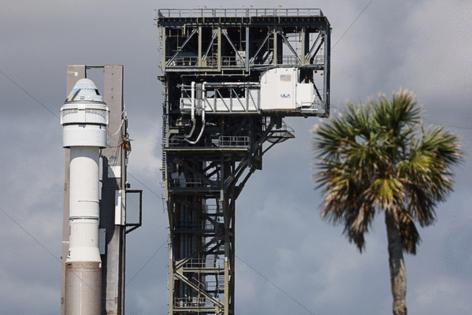Boeing aims for Starliner astronaut launch Monday after delays, $1.5 billion spent
Published in Science & Technology News
CAPE CANAVERAL, Fla. — Boeing has spent more than $1.5 billion to develop its CST-100 Starliner amid years of delays, but the payoff on its deal with NASA is on the horizon with the first human test flight set for launch Monday night.
Veteran NASA astronauts Butch Wilmore and Suni Williams will climb aboard the capsule for the Crew Flight Test atop a United Launch Alliance Atlas V rocket. It’s set to lift off from Canaveral’s Space Launch Complex 41 at 10:34 p.m. to the International Space Station.
The duo will return after eight days with a landing in the Western United States. The pair will test docking, undocking and landing procedures, including manual takeovers for what would normally be automated systems.
“The success of this mission has always been very important for us as a program for a lot of reasons,” said Mark Nappi, Boeing’s Starliner program manager during a launch readiness review last week. “Number one, we have humans flying on this vehicle. We always take that so seriously — human spaceflight. … Second is, this is an important capability for NASA, and so you know we signed up to go do this, and we’re going to go do it and be successful at it.”
ULA rolled the Atlas V to the pad Saturday morning from the Vertical Integration Facility amid clear blue skies with a forecast for Monday that expects a 95% chance for good weather. The first ever Atlas launch flew John Glenn to space in 1962 and this will mark the 100th Atlas rocket launch.
It’s also the first time since Apollo 7 in 1968 that humans will launch from the Canaveral launch pads with subsequent Apollo, space shuttle and SpaceX Crew Dragon flights all coming from neighboring Kennedy Space Center’s two launch pads.
But Boeing’s road to human spaceflight has been tortuous since NASA awarded the company alongside SpaceX the Commercial Crew Program contracts in 2014 to provide U.S.-based launches for its astronauts to the ISS. The goal was to stop reliance on Russia’s Soyuz flights, NASA’s only option after the space shuttle program ended in 2011.
“The first crewed flight of a new spacecraft is an absolutely critical milestone,” said NASA Associate Administrator Jim Free. “I don’t want to get too far ahead since we’ll still need to fly a successful mission, but when we do, and when we certify Starliner, the United States will have two unique human space transportations that provide critical redundancy for the ISS access.”
Boeing was in some ways deemed the safer bet by NASA under which it could earn up to $4.2 billion of the contract compared with SpaceX’s initial $2.6 billion. Each company was required to perform one successful uncrewed test flight to the ISS followed by a crewed flight, after which the spacecraft could be certified for use on up to six missions each under the initial contract.
Both companies faced development hurdles that pushed their first crewed test flights to 2019, but that’s when SpaceX surged forward while Boeing lagged behind.
...continued
©2024 Orlando Sentinel. Visit orlandosentinel.com. Distributed by Tribune Content Agency, LLC.







Comments